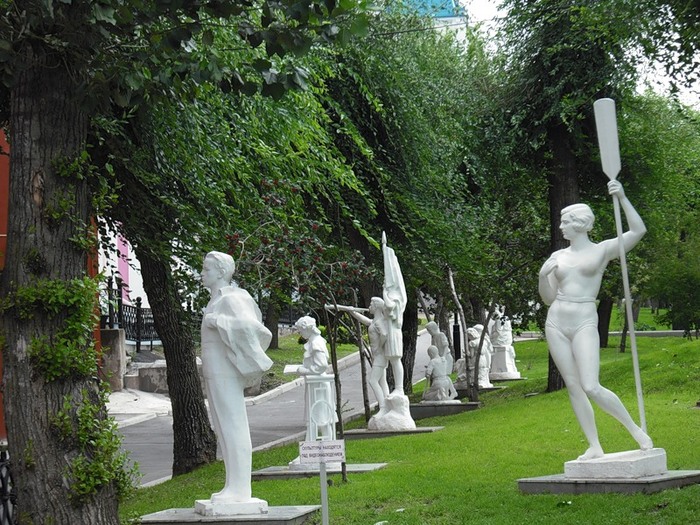From 1922 to 1991, on the map of the planet there was a state formation that was huge in area and had the most powerful economic potential - the Soviet Union (USSR). The sights of this country and monumental art still amaze today with their scope, massiveness and extraordinary realism. They have been preserved in many cities of the former superpower.
In this article you will find the most famous sights of the USSR: photos, the history of their construction and Interesting Facts about these objects. We will talk about one iconic building of the Soviet era and two majestic monuments that adorned Kyiv and Moscow.
USSR, architectural landmarks: Kharkov State Industry
If we talk about this, we cannot help but recall constructivism - a style that was very popular in the 20-30s. And among the most striking examples of this style is the so-called Gosprom (House of State Industry) in Kharkov. It was the very first skyscraper in the entire USSR.
The sights of Soviet architecture are distinguished by their massiveness and scale. The same can be said about the Gosprom building, built in 1928 from monolithic reinforced concrete on the main square of Kharkov (then the capital of the Ukrainian SSR).
The height of the building is 63 meters, and the total effective area of all its premises - about 60 thousand square meters. The construction of Gosprom took 9 thousand tons of metal and more than a thousand wagons of cement. The first Soviet skyscraper was served by 12 elevators (seven of them are still in operation).
USSR, monumental art attractions: “Motherland”
One of the most majestic and most famous monuments of the Soviet heritage is the “Motherland” in Kyiv. The author of this memorial was the architect Evgeniy Vuchetich. He also designed a similar monument in Volgograd.
Kiev Motherland has a height of 102 meters. The sculpture of a woman with a sword and shield is visible from many districts and residential areas of the Ukrainian capital. It was originally planned that the monument would be gilded, but this idea was later abandoned.
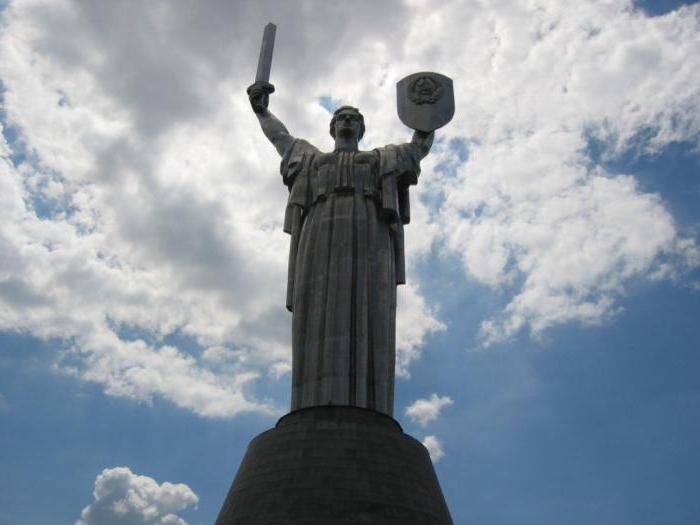
The monument was opened in 1981. It is located on the territory of the Museum of the History of Ukraine in the Second World War. The entire monument weighs 450 tons. It is designed so that it can withstand even a major earthquake of 8-9 magnitude. According to experts, the “Motherland” in Kyiv will stand for at least another 150 years.
Sculpture “Worker and Collective Farm Woman”
Listing all the most famous cultural sights of the USSR in the 20-30s, this object is worth mentioning first. We are talking about the famous sculpture “Worker and Collective Farm Woman”, installed in Moscow in 1939. By the way, for many foreigners it is perhaps the main symbol of the Soviet era.
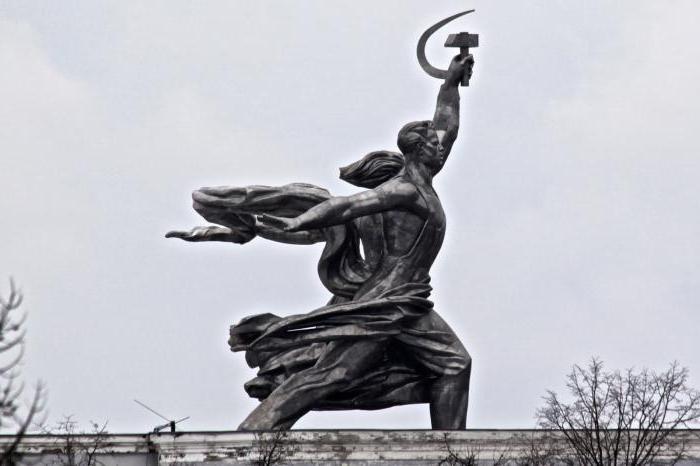
The 25-meter-tall stainless steel sculpture was originally made for the 1937 Paris World's Fair. After some time, it was transported to the capital of the USSR and installed near one of the entrances of the VDNH complex. Soon this monument became the emblem of the Mosfilm film studio.
In 2003, large-scale restoration of the monument began. The supporting frame of the sculpture was strengthened and its pedestal was replaced (as a result, it became ten meters higher). Today, under the monument there is a museum that tells in detail about the history of the creation of this monument of Soviet monumental art.
In 1918, Lenin's plan for monumental propaganda began. In accordance with this plan, monuments were removed that, in the opinion of the new government, did not represent historical or artistic value, for example, monuments to Alexander III in St. Petersburg and General Skobelev in Moscow. At the same time, monuments (busts, figures, steles, memorial plaques) began to be created to the heroes of the revolution, public figures, writers, and artists. The new monuments were supposed to make the ideas of socialism visually clear. Both famous masters (S.T. Konenkov, N.A. Andreev) and young sculptors were involved in the work different schools and directions right up to art school students. In total, 25 monuments were erected in Moscow over the years, and 15 in Petrograd. Many monuments did not survive, mainly because they were made of temporary materials (plaster, concrete, wood). Sculpture
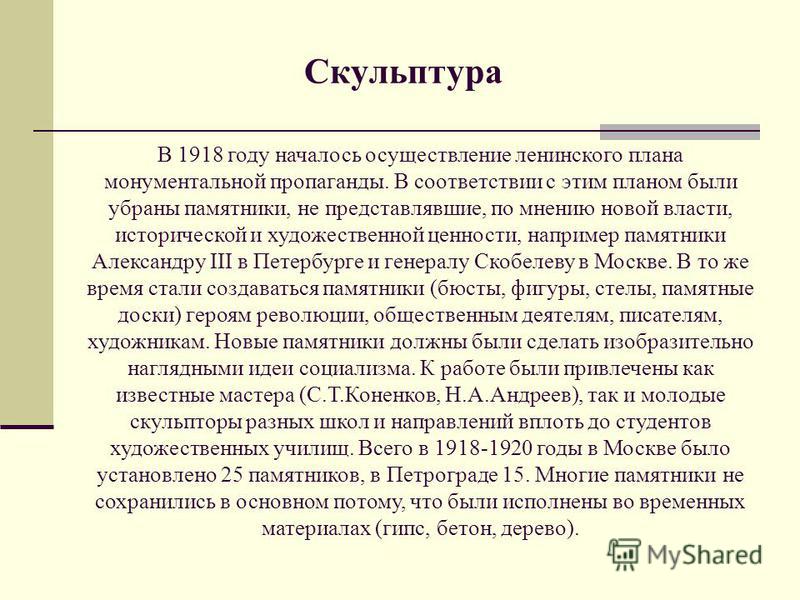
In Petrograd, over the years, a monument to the “Fighters of the Revolution” was created - the Field of Mars. Project by architect L.V. Rudneva.
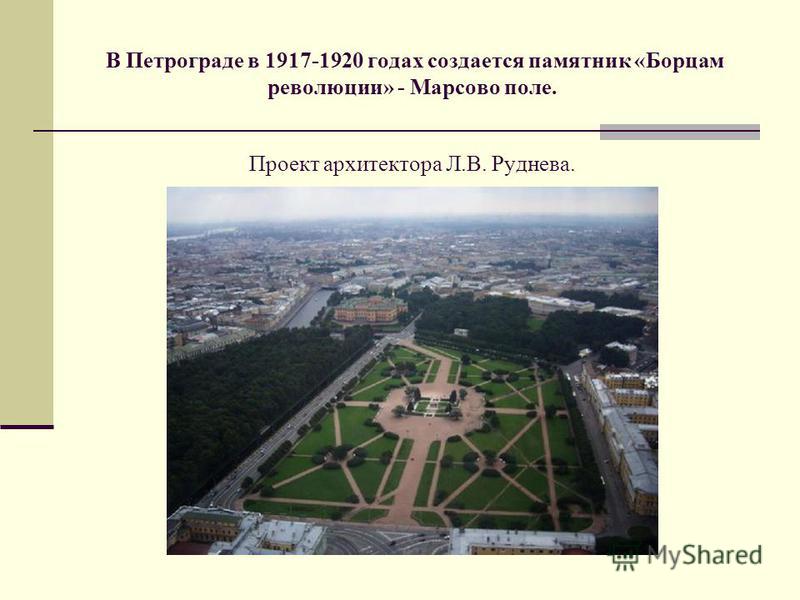
Obelisk in honor of the first Soviet Constitution in Moscow. Concrete Not preserved. Architect D. N. Osipov.
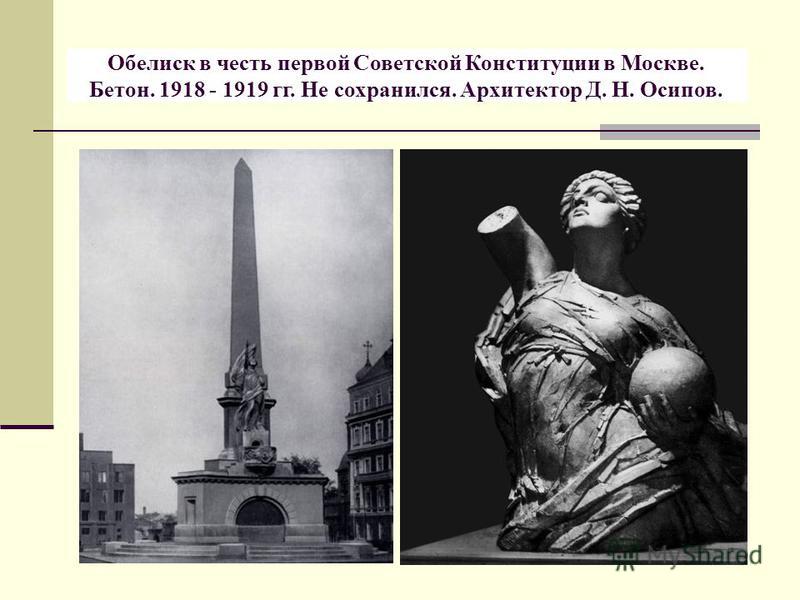
![]()
Sculpture group"Worker and Collective Farm Woman". They hold in their outstretched hands the hammer and sickle that make up the coat of arms Soviet Union. The author of this work is V.I. Mukhina, the largest sculptor of this era, one of the most famous women in the country.
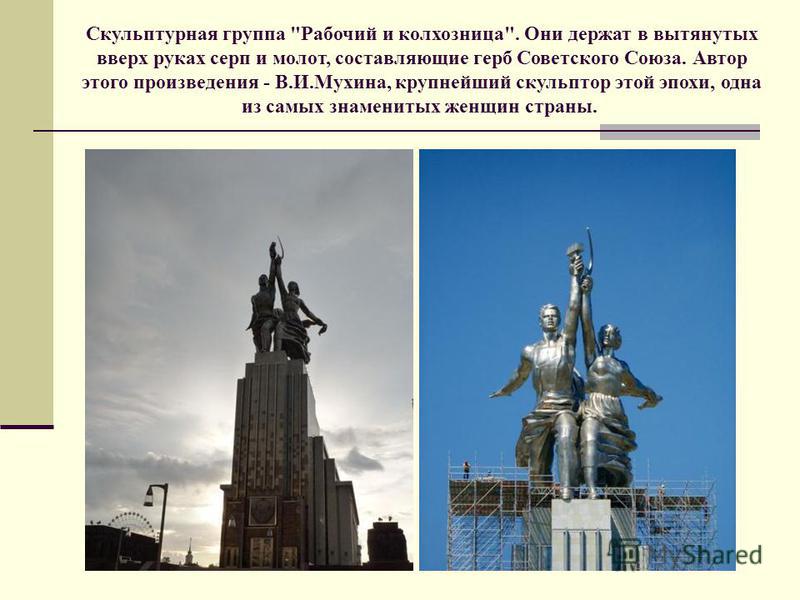
Architecture The leading direction in architecture in the 1920s was constructivism, which sought to use new technology to create simple, logical, functionally justified forms and expedient structures. Techniques characteristic of constructivism are the combination of solid planes with large glazed surfaces, the combination of volumes of different compositions. Soviet constructivism is represented in the works of V.E. Tatlin. He tried to use a wide variety of materials to build his technical designs, including wire, glass and metal sheets. The scope of club construction can be judged by the fact that 480 clubs were built in the country in just one year, including 66 in Moscow. A number of architecturally original clubs were built during this period according to the designs of the architect K.S. Melnikov in Moscow and the Moscow region.
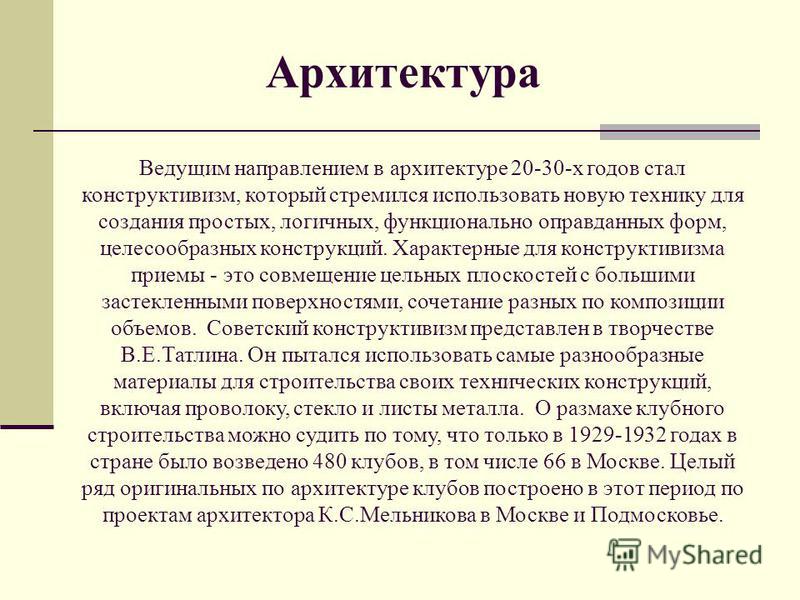
Club named after Rusakov in Sokolniki (years)
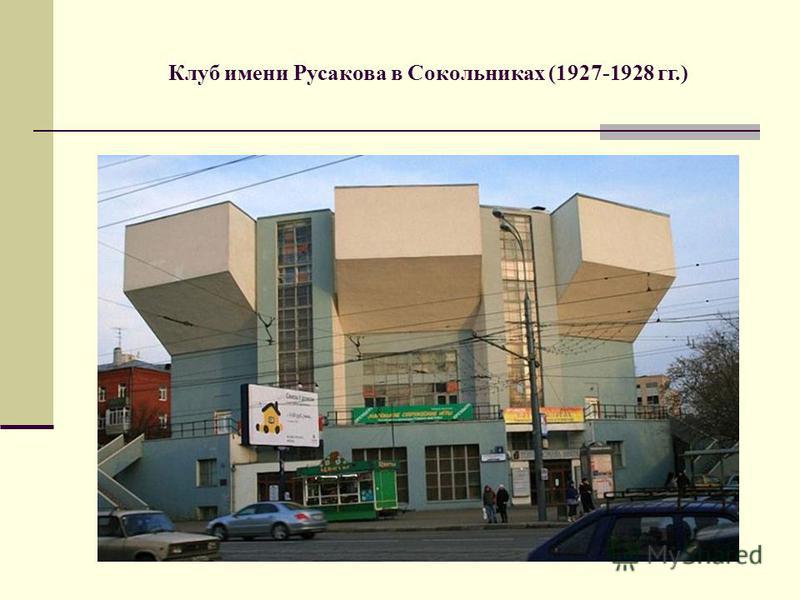
The most famous work of the Soviet sculptor Vera Mukhina is the monument “Worker and Collective Farm Woman”.
It was called a symbol of the Soviet era and a standard of socialist realism, although at one time the sculpture was almost rejected due to the fact that in the folds of a peasant woman’s dress someone saw the silhouette of the enemy of the people Leonid Trotsky... 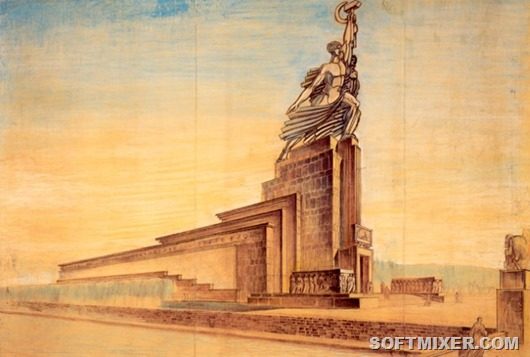
Project of the Soviet pavilion by architect B. Iofan
In 1936, the USSR was preparing to participate in World's Fair arts and technology in Paris. Architect Boris Iofan proposed making the Soviet pavilion in the form of a springboard, dynamically directed upward, with a sculpture on the roof.
Boris Iofan explained his idea this way:
“In the idea that I had, the Soviet pavilion was depicted as a triumphal building, reflecting in its dynamics the rapid growth of the achievements of the world’s first socialist state, the enthusiasm and cheerfulness of our great era of building socialism... So that any person, at the first glance at our pavilion, would feel that this is the pavilion of the Soviet Union... The sculpture seemed to me to be made of light, light metal, as if flying forward, like the unforgettable Louvre Nike - a winged victory.” 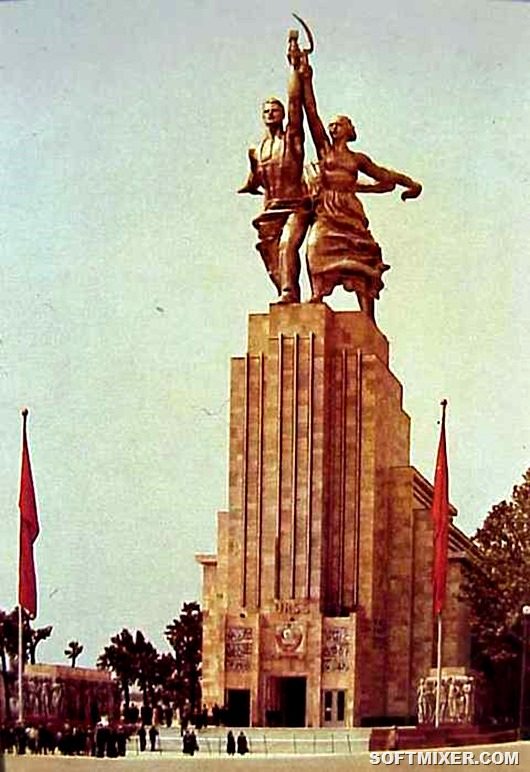
Soviet pavilion at an exhibition in Paris, 1937 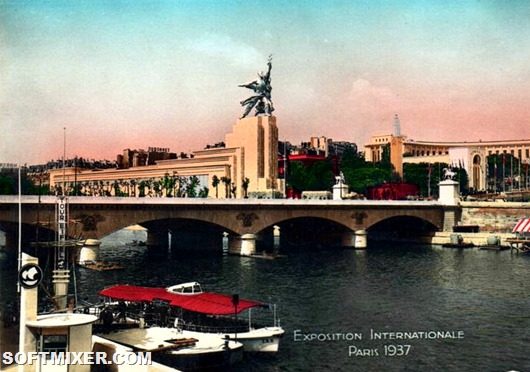
The exposition itself was rather sparse; in fact, the pavilion was the main exhibit. The worker and the collective farmer personified the owners of the Soviet land - the proletariat and the peasantry. Iofan’s idea for the composition was inspired by the antique statue “Tyran Slayers”.
The combination of a sickle and a hammer is also not the invention of Iofan and Mukhina; this idea has already been embodied in the works of some artists. The architect designed general project and find it specific solution was to be done by the sculptor. 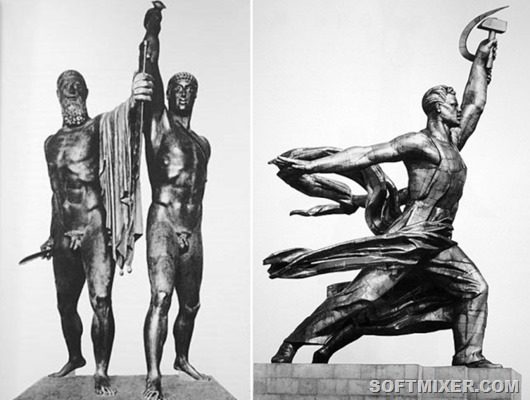
On the left are the Tyrant Slayers. V century BC e. On the right is a sculpture of Vera Mukhina *Worker and Collective Farm Woman*
In the summer of 1936, a competition was announced among sculptors, at which V. Andreev, M. Manizer, I. Shadr and V. Mukhina presented their projects. Mukhina’s main discovery was the apparent lightness and airiness of the massive sculpture, which was achieved thanks to the matter “flying” behind the figures.
“A lot of controversy was aroused by the piece of material I introduced into the composition, fluttering from behind, symbolizing those red banners, without which we cannot imagine any mass demonstration. This “scarf” was so necessary that without it the entire composition and connection of the statue with the building would fall apart,” said Mukhina.
Her project was approved, with the condition that she “dress” the figures, which were originally intended to be naked. 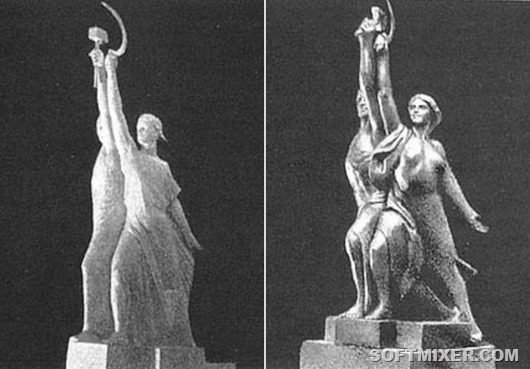
Sculpture projects by V. Andreev and M. Manizer 
Plaster model by B. Iofan and sculpture project by V. Mukhina
At the beginning of 1937, from the factory where the assembly took place, a denunciation was received against Mukhina, which stated that the work could not be completed on time, since the sculptor constantly interrupted work and demanded corrections, and in selected places The profile of the enemy of the people, L. Trotsky, is clearly visible from the steel shell of the frame.
Then they did not respond to the denunciation, but upon returning from the exhibition, the commissar of the Soviet pavilion I. Mezhlauk and several engineers who worked on the creation of the statue were arrested. 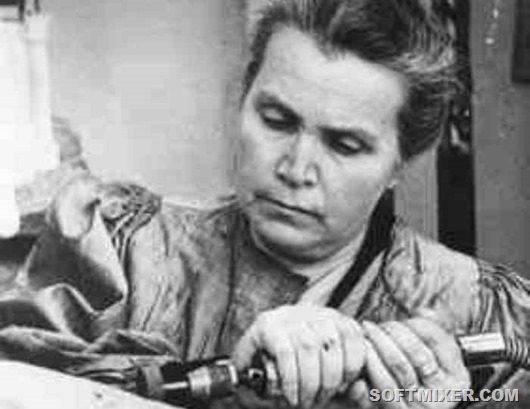
Vera Mukhina in the studio, 1940s. 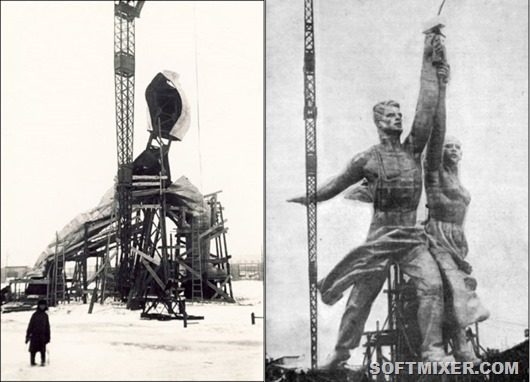
On the left is the assembly of the statue at the pilot plant. On the right is the assembled sculpture
The dimensions of the statue were impressive: it reached a height of 23.5 meters and weighed 75 tons. To transport it to the exhibition, the sculpture was cut into 65 pieces and loaded onto 28 platforms. After its assembly in Paris, the statue created a real sensation.
The French graphic artist F. Maserel admitted: “Your sculpture amazed us. We spend whole evenings talking and arguing about it.” Picasso admired the way he looked stainless steel against the backdrop of the lilac Parisian sky. 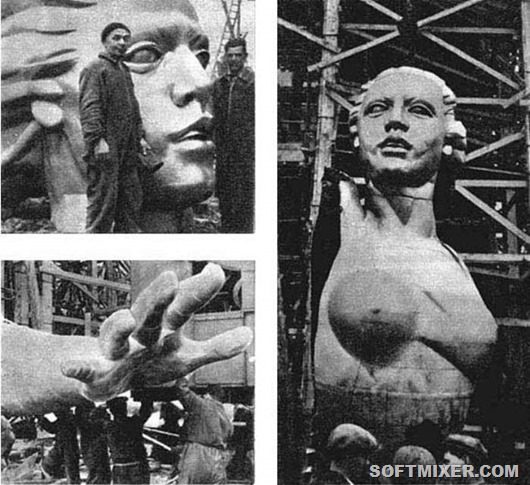
Statue assembly process
Romain Rolland wrote: “At the International Exhibition, on the banks of the Seine, two young Soviet giants raise the hammer and sickle, and we hear the heroic anthem pouring from their chests, which calls the peoples to freedom, to unity and will lead them to victory.” 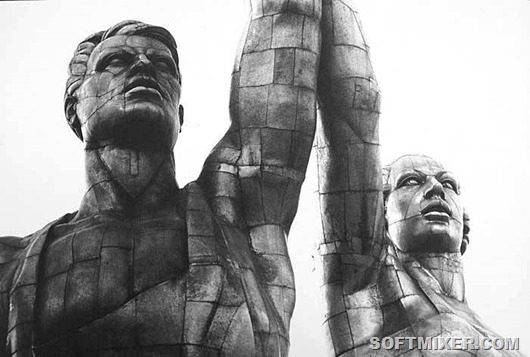
Working model of the sculpture 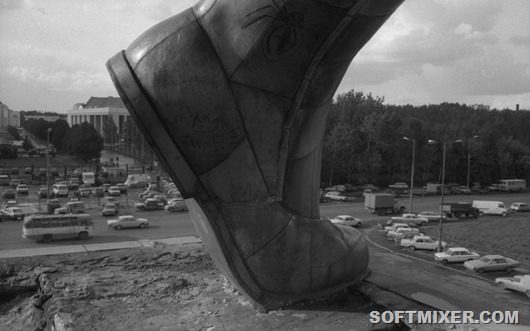
After the end of the exhibition, the sculpture was again dismantled and transported to Moscow. There it was restored from thick sheets of steel and installed on a much lower pedestal in front of the entrance to the All-Union Agricultural Exhibition. 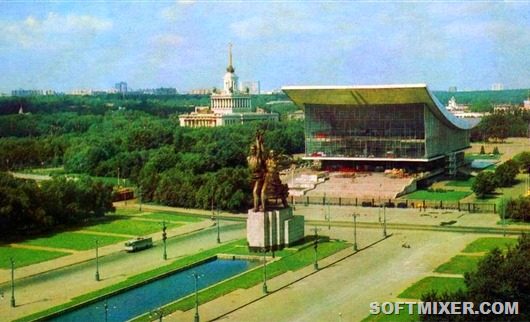
In 1947, the statue “Worker and Collective Farm Woman” became the symbol of the Mosfilm film studio. And Vera Mukhina deservedly received the unofficial title of the first lady of the Soviet Union monumental sculpture.
The most famous work of the Soviet sculptor Vera Mukhina is the monument “Worker and Collective Farm Woman”. It was called a symbol of the Soviet era and a standard of socialist realism, although at one time the sculpture was almost rejected due to the fact that in the folds of a peasant woman’s dress someone saw the silhouette of the enemy of the people Leonid Trotsky...
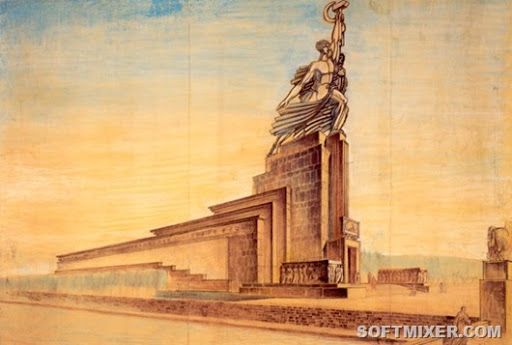
Project of the Soviet pavilion by architect B. Iofan
In 1936, the USSR was preparing to participate in the World Exhibition of Arts and Technology in Paris. Architect Boris Iofan proposed making the Soviet pavilion in the form of a springboard, dynamically directed upward, with a sculpture on the roof.
Boris Iofan explained his idea this way:
« In my idea, the Soviet pavilion was depicted as a triumphal building, reflecting in its dynamics the rapid growth of the achievements of the world's first socialist state, the enthusiasm and cheerfulness of our great era of building socialism... So that any person, at the first glance at our pavilion, would feel that this is the pavilion of the Soviet Union ... The sculpture seemed to me to be made of light, light metal, as if flying forward, like the unforgettable Louvre Nike - a winged victory.”
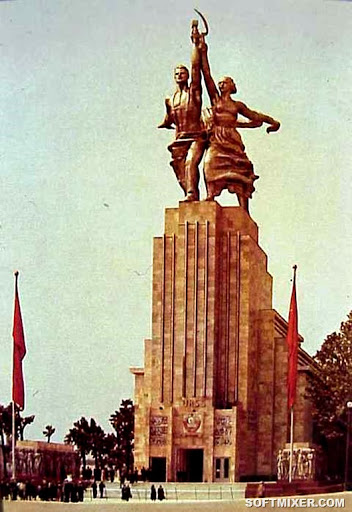
Soviet pavilion at an exhibition in Paris, 1937
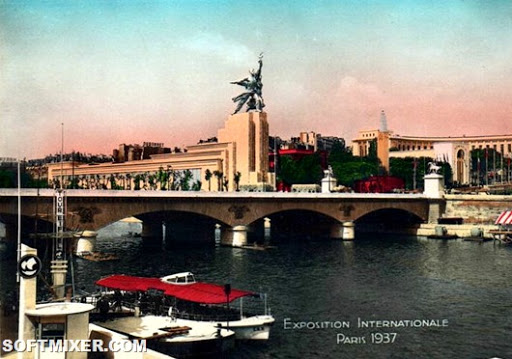
The exposition itself was rather sparse; in fact, the pavilion was the main exhibit. The worker and the collective farmer personified the owners of the Soviet land - the proletariat and the peasantry. Iofan’s idea for the composition was inspired by the antique statue “Tyran Slayers”.
The combination of a sickle and a hammer is also not the invention of Iofan and Mukhina; this idea has already been embodied in the works of some artists. The architect developed the general project, and the sculptor had to find its specific solution.
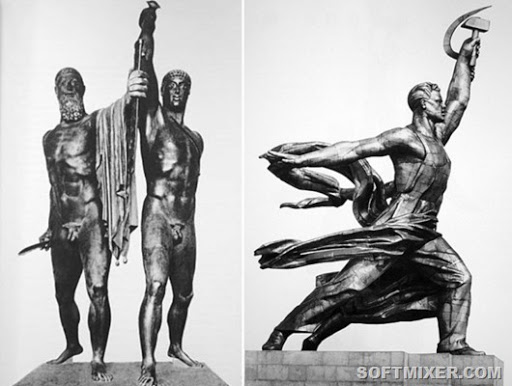
On the left are the Tyrant Slayers. V century BC e. On the right is a sculpture of Vera Mukhina *Worker and Collective Farm Woman*
In the summer of 1936, a competition was announced among sculptors, at which V. Andreev, M. Manizer, I. Shadr and V. Mukhina presented their projects. Mukhina’s main discovery was the apparent lightness and airiness of the massive sculpture, which was achieved thanks to the matter “flying” behind the figures.
« A lot of controversy was aroused by the piece of material I introduced into the composition, fluttering from behind, symbolizing those red banners, without which we cannot imagine any mass demonstration. This “scarf” was so necessary that without it the entire composition and connection of the statue with the building would fall apart,”- said Mukhina.
Her project was approved, with the condition that she “dress” the figures, which were originally intended to be naked.
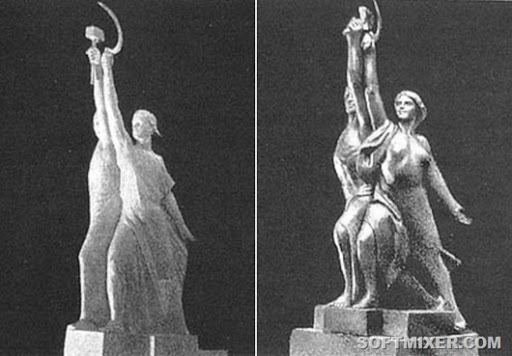
Sculpture projects by V. Andreev and M. Manizer
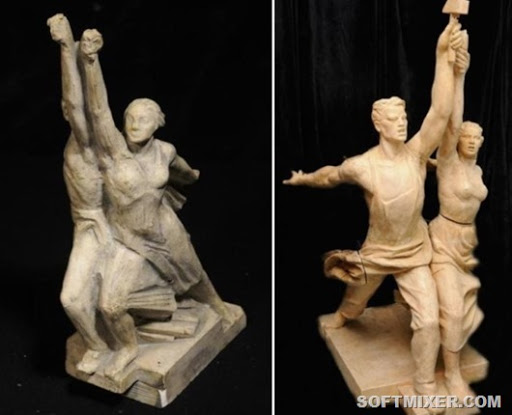
Plaster model by B. Iofan and sculpture project by V. Mukhina
At the beginning of 1937, from the factory where the assembly took place, a denunciation was received against Mukhina, which stated that the work could not be completed on time, since the sculptor constantly interrupted work and required corrections, and in some places the steel shell of the frame was clearly the profile of the enemy of the people L. Trotsky is visible.
Then they did not respond to the denunciation, but upon returning from the exhibition, the commissar of the Soviet pavilion I. Mezhlauk and several engineers who worked on the creation of the statue were arrested.
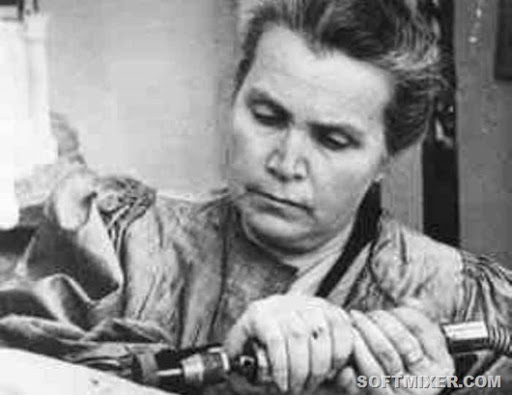
Vera Mukhina in the studio, 1940s.

On the left is the assembly of the statue at the pilot plant. On the right is the assembled sculpture
The dimensions of the statue were impressive: it reached a height of 23.5 meters and weighed 75 tons. To transport it to the exhibition, the sculpture was cut into 65 pieces and loaded onto 28 platforms. After its assembly in Paris, the statue created a real sensation.
The French graphic artist F. Maserel admitted: “ Your sculpture amazed us. We spend whole evenings talking and arguing about it.” Picasso admired the way stainless steel looked against the lilac Parisian sky.
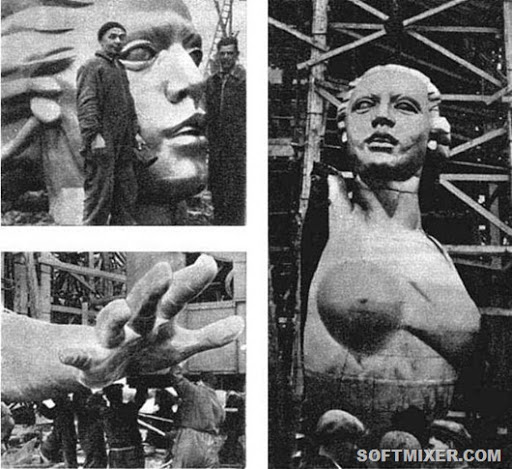
Statue assembly process
Romain Rolland wrote: “At the International Exhibition, on the banks of the Seine, two young Soviet giants raise the hammer and sickle, and we hear the heroic anthem pouring from their chests, which calls the peoples to freedom, to unity and will lead them to victory.”
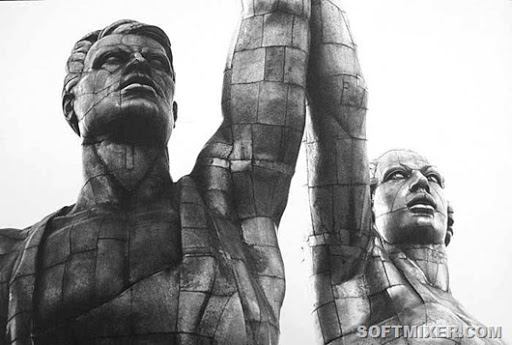
Working model of the sculpture
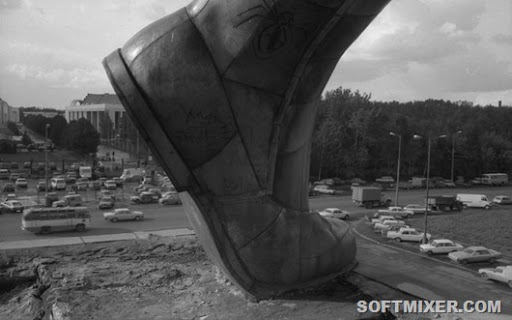
After the end of the exhibition, the sculpture was again dismantled and transported to Moscow. There it was restored from thick sheets of steel and installed on a much lower pedestal in front of the entrance to the All-Union Agricultural Exhibition.
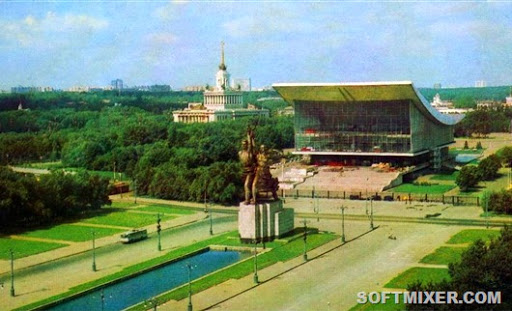
In 1947, the statue “Worker and Collective Farm Woman” became the symbol of the Mosfilm film studio. And Vera Mukhina deservedly received the unofficial title of the first lady of Soviet monumental sculpture. link
A real park has opened in Khabarovsk Soviet period. Girls with an oar, pioneers with bugles, statues of leaders - dozens of monuments of the communist era have found a new life through the efforts of the staff of the Local History Museum.
A restorer removes layer by layer of paint from a sculpture of glider boys. In the Land of Soviets, statues of October students, teachers and sportsmen were updated before each public holiday. After half a century, they can only be cleaned with a hammer and chisel.
Roman Bosov, sculptor: “These monuments are in a terrible state. It would be one thing if they were, say, partially deformed or destroyed. It is much easier to restore a figure that has not been restored. Now a lot of effort goes into removing traces of the inept repairs of predecessors,”
The missing parts of the sculptures are restored using old photographs. First, a blank is molded from plasticine, then the parts are cast from concrete. After puttying and painting, the statue is sent to the local Museum of Local Lore.
Nikolai Ruban, director of the Museum of Local Lore: “We plan to conduct real excursions, because you can tell a lot about each person. We have a monument to Mikhail Kalinin and Vladimir Ulyanov, a girl with a bugle, a boy with an oar, and many other interesting things.”
Museum workers decided to create a park of Soviet sculpture several years ago. When the Museum of Local Lore received money for the construction of a new building, the director decided to spend part of the funds on saving Soviet monuments. Abandoned sculptures were collected throughout the region; statues were looked for in factories and factories, in old courtyards and even in landfills.
Lyudmila Kara-Ulanova, employee of the Museum of Local Lore: “Many statues were brought from the pioneer camp. For example, a girl with a book, girls with pigeons and a pioneer with a bugle.”
The heyday of Soviet sculpture in Khabarovsk occurred in the 50s. Almost all the statues were cast using molds sent from Moscow and Leningrad. Pioneers and excellent students of the TRP decorated the courtyards of houses in which the party elite lived.
But now “Stalin” buildings are crowding out office buildings. After graduation construction work historians cannot even find pedestals from monuments of the Soviet past.
Alexey Shestakov, historian: “Initially, we turned to the Society for the Protection of Monuments and looked at their card index. And after that they began to ask their relatives and acquaintances who had seen any monuments in the city. Unfortunately, by now most park sculptures disappeared."
The Soviet Sculpture Park opened to visitors this summer. The new exhibition will feature only about 10 statues from the socialist realism era. Over the years, serial products have become real museum rarities.
